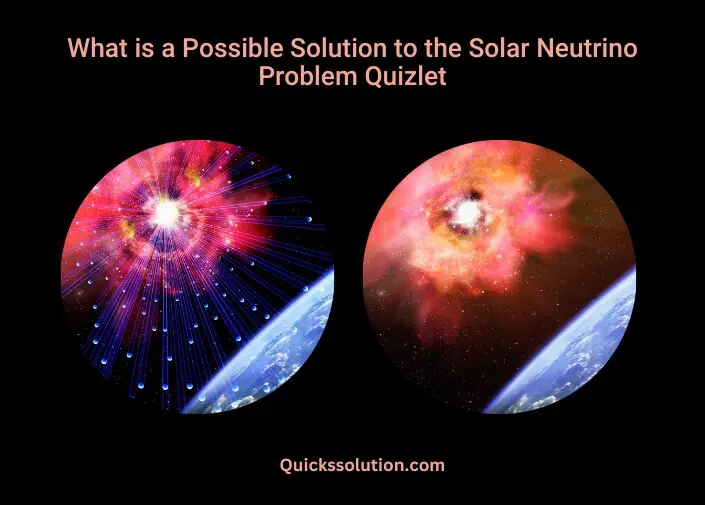Published on: April 15, 2023
Written by John Stevens / Fact-checked by Hashim Manna
The Solar Neutrino Problem has puzzled scientists for decades, as they observed a discrepancy between the expected number of solar neutrinos and the number detected on Earth. This article will take you through the ins and outs of solar neutrinos, the problem at hand, and delve into a possible solution – the Neutrino Oscillation Theory. Are you ready to embark on this intriguing scientific journey? Let’s dive in!

Solar Neutrinos
What are Neutrinos?
Neutrinos are subatomic particles with no electric charge and an extremely small mass. They rarely interact with other matter, which makes them extremely difficult to detect. Neutrinos are produced in various processes such as nuclear reactions, radioactive decay, and supernovae explosions.
Solar Neutrinos and the Sun
In the case of the Sun, neutrinos are generated during nuclear fusion reactions, where hydrogen atoms combine to form helium, releasing energy in the form of neutrinos. These solar neutrinos travel at near the speed of light and provide us with valuable information about the inner workings of our Sun.
The Solar Neutrino Problem
Detection of Solar Neutrinos
Scientists have designed several experiments to detect solar neutrinos, such as the Homestake Experiment and Super-Kamiokande. These experiments use large underground detectors filled with a specific medium, like water or chlorine, which occasionally interact with neutrinos, producing detectable signals.
The Deficit Issue
The Solar Neutrino Problem arises when the number of detected solar neutrinos is significantly lower than the theoretical predictions based on our understanding of the Sun’s nuclear fusion processes. This discrepancy has led to intense research and various theories to solve the problem.
Possible Solutions to the Solar Neutrino Problem
Experimental Errors
One possibility is that the detectors are simply not sensitive enough or are prone to errors, leading to an underestimation of the neutrino count. However, as technology has advanced and new detectors have been developed, this explanation becomes less likely.
Neutrino Oscillation Theory
Another potential solution is the Neutrino Oscillation Theory, which suggests that neutrinos can change their “flavor” (electron, muon, or tau) as they travel through space. This flavor change could account for the discrepancy observed in the solar neutrino experiments.
Neutrino Oscillation as a Solution
The Flavor Change
The Neutrino Oscillation Theory states that neutrinos are produced in one flavor (e.g., electron neutrinos in the Sun) and can oscillate into other flavors as they travel to Earth. Since most detectors are sensitive only to electron neutrinos, they would miss the muon and tau neutrinos, leading to an apparent deficit in the observed neutrino count.
Experimental Evidence
In recent years, several experiments have provided strong evidence supporting the Neutrino Oscillation Theory. The Sudbury Neutrino Observatory (SNO) in Canada, for instance, has successfully detected both electron and non-electron neutrinos, confirming the flavor change. Additionally, the Super-Kamiokande experiment in Japan has observed neutrino oscillations in atmospheric neutrinos, further supporting this theory.
Implications of the Solar Neutrino Solution
Fundamental Particle Physics
The discovery of neutrino oscillations has had a profound impact on the field of particle physics. It has confirmed that neutrinos have mass, a property previously thought to be negligible or even nonexistent. This has led to revisions in the Standard Model of particle physics and triggered new research in neutrino properties and their role in the universe.
Stellar Evolution
The confirmation of neutrino oscillations has also resolved the Solar Neutrino Problem, leading to a better understanding of the Sun’s nuclear fusion processes. This has implications for the study of stellar evolution, as it provides a more accurate picture of how stars like the Sun generate energy and evolve over time.
Future Research
While the Neutrino Oscillation Theory has emerged as a leading solution to the Solar Neutrino Problem, there are still many questions to be answered. Future research will continue to explore the properties of neutrinos, their role in the cosmos, and the possibility of new, undiscovered neutrino flavors or interactions.
The Bottom Line
In conclusion, the Solar Neutrino Problem has been a compelling scientific mystery for decades. The Neutrino Oscillation Theory has emerged as a possible solution, explaining the observed deficit in solar neutrinos by suggesting that neutrinos change flavors as they travel from the Sun to Earth. This discovery has had significant implications for both particle physics and stellar evolution, and it continues to inspire new research in the field.
FAQs
What are solar neutrinos?
Solar neutrinos are subatomic particles produced during nuclear fusion reactions in the Sun, where hydrogen atoms combine to form helium.
What is the Solar Neutrino Problem?
The Solar Neutrino Problem refers to the discrepancy between the expected number of solar neutrinos and the number detected on Earth, which has puzzled scientists for decades.
What is the Neutrino Oscillation Theory?
The Neutrino Oscillation Theory suggests that neutrinos can change their “flavor” (electron, muon, or tau) as they travel through space, which could account for the discrepancy observed in the solar neutrino experiments.
How does the Neutrino Oscillation Theory solve the Solar Neutrino Problem?
The Neutrino Oscillation Theory solves the Solar Neutrino Problem by explaining that the observed deficit in solar neutrinos is due to their flavor change during their journey from the Sun to Earth, as most detectors are sensitive only to electron neutrinos.
What are the implications of the Neutrino Oscillation Theory?
The discovery of neutrino oscillations has implications for both particle physics, leading to revisions in the Standard Model, and stellar evolution, providing a more accurate picture of how stars generate energy and evolve over time.
Read more:




